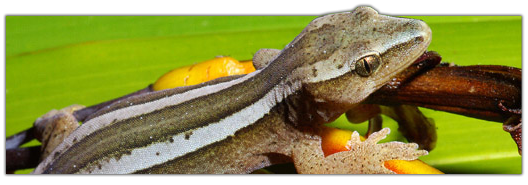
New Zealand geckos (Diplodactylidae): Cryptic diversity in a post-Gondwanan lineage with trans-Tasman affinities
Stuart V. Nielsena, Aaron M. Bauera, Todd R. Jackmana, Rod A. Hitchmoughb & Charles H. Daughertyc
Abstract
We used a multi-gene approach to assess the phylogenetic relationships of New Zealand diplodactylid geckos to their Australian and New Caledonian relatives and to one another. Data from nuclear (RAG-1, PDC) and mitochondrial (ND2, 16S) genes from >180 specimens representing all 19 recognized New Zealand taxa and all but two of 20 putatively new species suggested by previous studies were analyzed using Maximum Parsimony, Maximum Likelihood and Bayesian inference. All analyses retrieved a monophyletic New Zealand clade, most closely related to the Australian Diplodactylidae exclusive of Pseudothecadactylus. Hoplodactylus is paraphyletic and composed of two morphological groups: a broad-toed clade, consisting of the island-restricted, largest extant species, Hoplodactylus duvaucelii, and the species-rich, wide-ranging Hoplodactylus maculatus clade; and a narrow-toed clade, comprising five monophyletic subgroups: Naultinus, the Hoplodactylus pacificus and Hoplodactylus granulatus clades, and the distinctive species Hoplodactylus rakiurae and Hoplodactylus stephensi. Each of these lineages is here recognized at the generic level. Our data support recognition of 16 new species (36 total), and five new or resurrected genera (seven total). The New Zealand diplodactylid radiation split from its Australian relatives 40.2 mya (95% highest posterior density estimate 28.9–53.5), after the opening of the Tasman Sea. Their distribution cannot, therefore, be regarded as derived as a result of Gondwanana vicariance. The age of the New Zealand crown group, 24.4 mya (95% highest posterior density estimate 15.5–33.8), encompasses the period of the ‘Oligocene drowning’ of New Zealand and is consistent with the hypothesis that New Zealand was not completely inundated during this period. Major lineages within New Zealand geckos diverged chiefly during the mid- to late Miocene, probably in association with a suite of geological and climatological factors that have characterized the region’s complex history.
Come si legge nell'Abstract del lavoro di Nielsena et al., il genere Hoplodactylus viene diviso in 6 generi di cui 5 nuovi o ripristinati. Nei sei generi descritti da Nielsena et al., sono incluse le 11 specie di Hoplodactylus riconosciute fino ad oggi e si aggiunge Woodworthia brunneus (Cope 1869) che era collocata come sinonimo di Hoplodactylus pacificus (Gray 1842).
Il genere Naultinus non subisce enormi cambiamenti, se non l'elevazione a specie di Naultinus punctatus (Gray 1843), fino ad oggi riconosciuta come sottospecie di N. elegans (Gray 1842) e la regresione di N. poecilochloris (Robb and Hitchmough 1980) a sinonimo di N. tuberculatus (Mcccann 1955).
In conclusione, gli studi di Nielsena e i suoi colleghi supportano il riconoscimento di 16 nuove specie (36 in totale) e 5 nuovi generi (7 in totale).
Proposta di classificazione dei gechi della Nuova Zelanda:
- Type species: Hoplodactylus duvaucelii (Duméril and Bibron 1836)
Include le specie: H. delcourti Bauer and Russell 1986 e Hoplodactylus duvaucelii. - Type species: Naultinus elegans (Gray 1842)
Include le specie: Naultinus elegans (Gray 1842), N. gemmeus (Gray 1869), N. grayii (Bell 1843), N. manukanus (McCann 1955), N. punctatus (Gray 1843), N. rudis (Fischer 1882), N. stellatus (Hutton 1872), N. tuberculatus (McCann 1955) e la nuova specie putativa N. "North Cape". Naultinus poecilochloris (Robb and Hitchmough 1980) viene considerato sinonimo di N. tuberculatus come da Hitchmough (1997). - Type species: Dactylocnemis pacificus (Gray 1842)
Include le specie: D. pacificus (Gray 1842) e le nuove specie putative D. “North Cape”, D. “Three Kings”, D. "Poor Knights", D. "Mokohinaus", e D. "Matapia". - Type species: Woodworthia digitata (Garman 1901) = Woodworthia maculatus (Gray 1845)
Include le specie: W. brunneus (Cope 1869), W. chrysosireticus (Robb 1980), W. maculatus (Gray 1845), così come le nuove specie putative W. "Southern ini", W. "Marlborough Mini", W. "Pygmy", W. "Kaikouras", W. "Mt. Arthur", W. "Cromwell Gorge", W. "Central Otago", W. "Southern Alps" e W. "Otago/Southland". - Tukutuku (nuovo genere)
Type species: Tukutuku rakiurae (Thomas 1981); monotipico.
Etimologia: Parola Maori per definire un ornamento dal disegno reticolato, intricato e bello. Parola che si riferisce alla livrea di questo geco neozelandese. I sostantivi Maori spesso non hanno un sesso, ma in questo caso Tukutuku viene usato al maschile ai fini nomenclaturali. - Toropuku (nuovo genere)
Type species: T. stephensi (Robb 1980); monotipico.
Etimologia: Deriva dalla parola Maori che significa "segreto o nascosto" riferito alle abitudini criptiche e alle poche informazioni riguardanti questa specie. I sostantivi Maori spesso non hanno un sesso, ma in questo caso Toropuku viene usato al maschile ai fini nomenclaturali. - Mokopirirakau (nuovo genere)
Type species: Mokopirirakau granulatus (Gray 1845)
Etimologia: Moko-piri-rakau è il nome Maori della foresta del geco. I sostantivi Maori spesso non hanno un sesso, ma in questo caso Mokopirirakau viene usato al maschile ai fini nomenclaturali.
Included species. Mokopirirakau granulatus (Gray 1845), M. kahutarae (Whitaker 1984), M. nebulosus (McCann 1955), M. cryptozoicus (Jewell and Leschen 2004) e le nuove specie putative M. "Southern North Island", M. "Southern Forest", M. "Roy‘s Peak", M. "Okarito", M. "Cascades", e M. "Open Bay Islands".
Per approfondire questo argomento, acquista l'articolo.